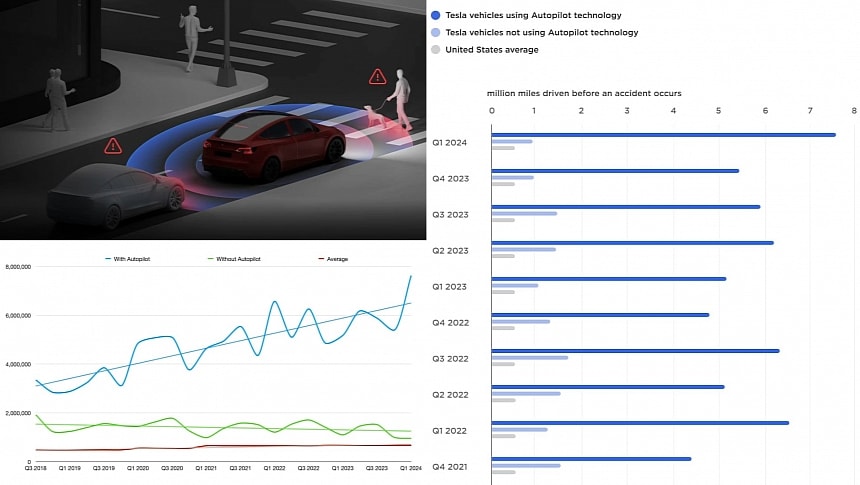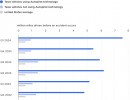Tesla used to offer quarterly reports about accidents involving its Autopilot safety assistance system. However, it has been doing a lousy job lately when new reports have been released sporadically. The EV maker finally released the Q1 2024 safety data after more than a year of radio silence.
Tesla has always claimed that its driver assistance systems, Autopilot and Full Self-Driving, make driving significantly safer. Since 2018, the EV maker has released a "Tesla vehicle safety report," highlighting the safety benefits of using the Autopilot system. Initially, the report was released every quarter, but Tesla went silent in 2022.
In January 2023, it published a new round of reports, including the missing ones, until Q3 2022. It also re-assessed previously published records, which made people question the data. At the time, Tesla explained that it eliminated events where no airbag or active restraints were deployed and those counted more than once, as well as reports of invalid or duplicate mileage records.
In March 2023, Tesla released the safety report for Q4 2022, and things appeared to be in good order. The same month, during Investor Day, Tesla offered a glimpse into FSD safety data for the first time. This openness was highly appreciated by analysts and Tesla fans alike. The data supported Tesla's claims that its driver assistance systems make driving much safer than driving without them.
However, Tesla stopped publishing any new safety reports after March 2023. As before, it did not explain why it stopped publishing the reports. On Wednesday, Tesla released a new round of reports after a one-year hiatus, again without offering an explanation. This time, the records include safety data for Q1 2024, making them the most up-to-date reports Tesla has released until now.
The Q1 2024 report marks a significant improvement in Autopilot safety, being the best historical result. According to safety data, Tesla recorded one crash every 7.63 million miles driven on Autopilot. For drivers who were not using Autopilot technology, Tesla recorded one crash every 955,000 miles driven. This compares favorably with the most recent data from the NHTSA and FHWA, which show that the US records roughly one crash for every 670,000 miles.
Crash data is best compared year over year, considering the impact different seasons have on accident rates. In the first quarter of 2023, Tesla recorded one crash for every 5.18 million miles driven on Autopilot. However, driving without Autopilot activated yielded better results in 2023, with one collision every 1.10 million miles driven. Tesla counts every event when airbags or other restraint systems deploy, regardless of who is to blame.
Tesla has been criticized in the past because the Autopilot crash data doesn't offer a relevant representation of the company's driver assistance systems' safety. This is because Autopilot is used mostly on highways, where the accident rates are usually lower. Now that Tesla also uses the FSD software stack for Autopilot, things are even more confusing. It will be interesting to see some new FSD data similar to what Tesla released during the 2023 Investor Day. This could happen at this year's Shareholder Meeting, scheduled for June 13.
In January 2023, it published a new round of reports, including the missing ones, until Q3 2022. It also re-assessed previously published records, which made people question the data. At the time, Tesla explained that it eliminated events where no airbag or active restraints were deployed and those counted more than once, as well as reports of invalid or duplicate mileage records.
In March 2023, Tesla released the safety report for Q4 2022, and things appeared to be in good order. The same month, during Investor Day, Tesla offered a glimpse into FSD safety data for the first time. This openness was highly appreciated by analysts and Tesla fans alike. The data supported Tesla's claims that its driver assistance systems make driving much safer than driving without them.
However, Tesla stopped publishing any new safety reports after March 2023. As before, it did not explain why it stopped publishing the reports. On Wednesday, Tesla released a new round of reports after a one-year hiatus, again without offering an explanation. This time, the records include safety data for Q1 2024, making them the most up-to-date reports Tesla has released until now.
The Q1 2024 report marks a significant improvement in Autopilot safety, being the best historical result. According to safety data, Tesla recorded one crash every 7.63 million miles driven on Autopilot. For drivers who were not using Autopilot technology, Tesla recorded one crash every 955,000 miles driven. This compares favorably with the most recent data from the NHTSA and FHWA, which show that the US records roughly one crash for every 670,000 miles.
Crash data is best compared year over year, considering the impact different seasons have on accident rates. In the first quarter of 2023, Tesla recorded one crash for every 5.18 million miles driven on Autopilot. However, driving without Autopilot activated yielded better results in 2023, with one collision every 1.10 million miles driven. Tesla counts every event when airbags or other restraint systems deploy, regardless of who is to blame.
Tesla has been criticized in the past because the Autopilot crash data doesn't offer a relevant representation of the company's driver assistance systems' safety. This is because Autopilot is used mostly on highways, where the accident rates are usually lower. Now that Tesla also uses the FSD software stack for Autopilot, things are even more confusing. It will be interesting to see some new FSD data similar to what Tesla released during the 2023 Investor Day. This could happen at this year's Shareholder Meeting, scheduled for June 13.







